Early Childhood Education: Infant Reflexes, Motor Skills, and Senses
VerifiedAdded on 2023/01/11
|5
|1058
|40
Report
AI Summary
This report provides an overview of early childhood development, specifically focusing on infants aged 0-12 months. It details newborn reflexes, including blinking, rooting, sucking, and grasping, and their timelines. The report differentiates between fine and gross motor skills, outlining the progression of these skills from birth to 24 months, such as grasping, crawling, and walking. Furthermore, it explores the development of the senses – touch, hearing, smell, and taste – and how infants respond to various stimuli. The report also includes developmental milestones for both gross and fine motor skills, providing a comprehensive understanding of infant development, supported by references to relevant research and frameworks like the Early Years Learning Framework.
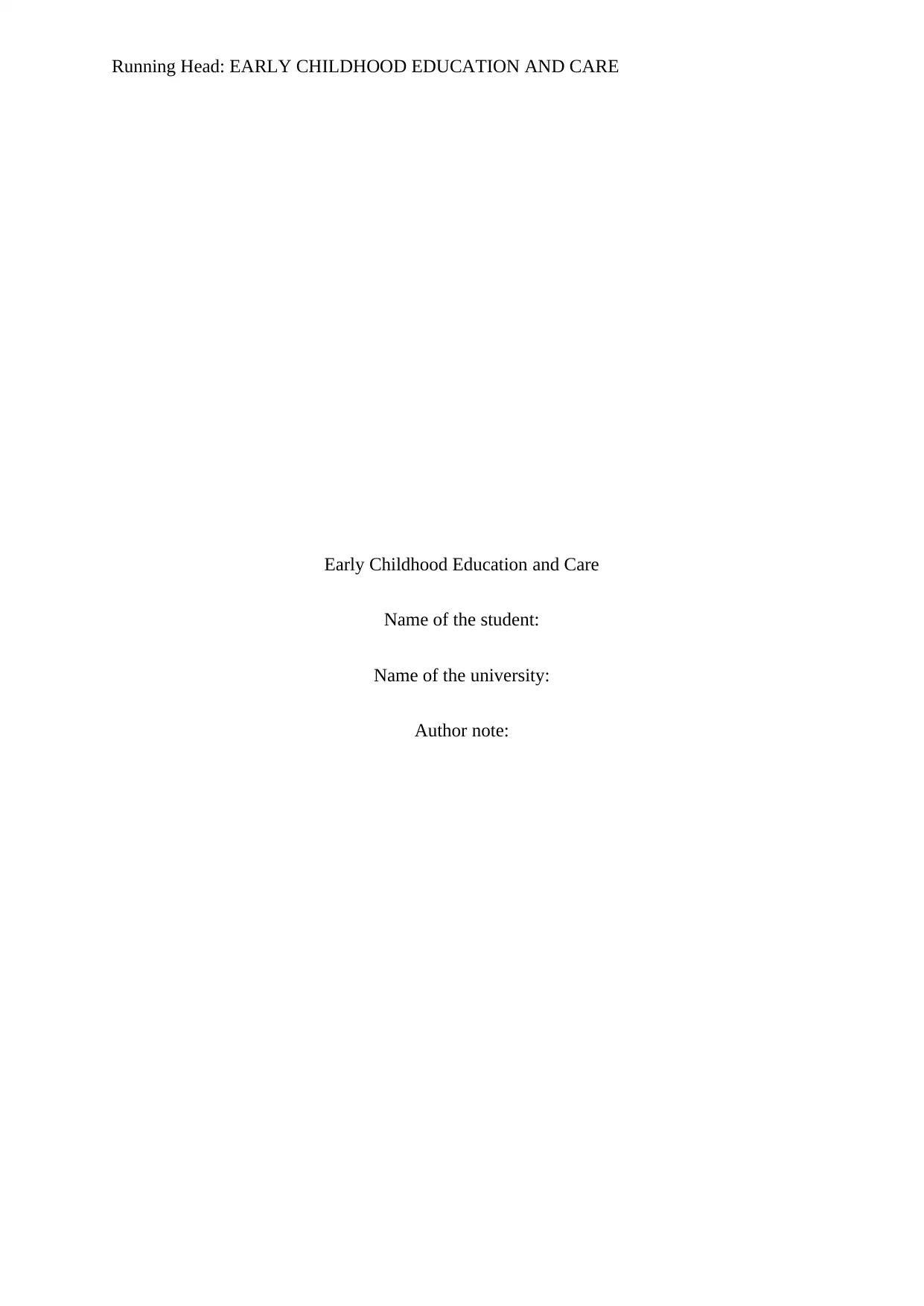
Running Head: EARLY CHILDHOOD EDUCATION AND CARE
Early Childhood Education and Care
Name of the student:
Name of the university:
Author note:
Early Childhood Education and Care
Name of the student:
Name of the university:
Author note:
Paraphrase This Document
Need a fresh take? Get an instant paraphrase of this document with our AI Paraphraser
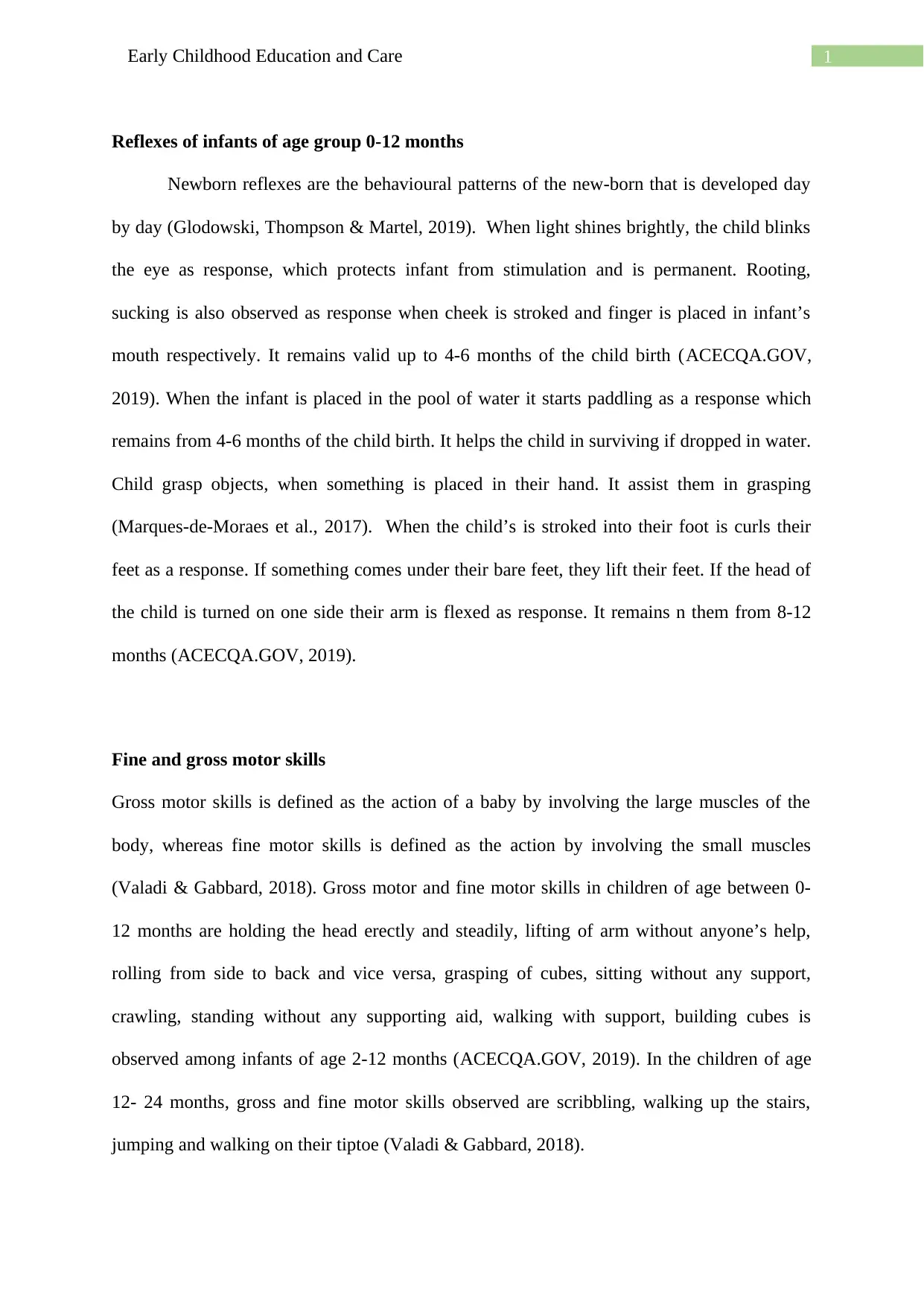
1Early Childhood Education and Care
Reflexes of infants of age group 0-12 months
Newborn reflexes are the behavioural patterns of the new-born that is developed day
by day (Glodowski, Thompson & Martel, 2019). When light shines brightly, the child blinks
the eye as response, which protects infant from stimulation and is permanent. Rooting,
sucking is also observed as response when cheek is stroked and finger is placed in infant’s
mouth respectively. It remains valid up to 4-6 months of the child birth (ACECQA.GOV,
2019). When the infant is placed in the pool of water it starts paddling as a response which
remains from 4-6 months of the child birth. It helps the child in surviving if dropped in water.
Child grasp objects, when something is placed in their hand. It assist them in grasping
(Marques-de-Moraes et al., 2017). When the child’s is stroked into their foot is curls their
feet as a response. If something comes under their bare feet, they lift their feet. If the head of
the child is turned on one side their arm is flexed as response. It remains n them from 8-12
months (ACECQA.GOV, 2019).
Fine and gross motor skills
Gross motor skills is defined as the action of a baby by involving the large muscles of the
body, whereas fine motor skills is defined as the action by involving the small muscles
(Valadi & Gabbard, 2018). Gross motor and fine motor skills in children of age between 0-
12 months are holding the head erectly and steadily, lifting of arm without anyone’s help,
rolling from side to back and vice versa, grasping of cubes, sitting without any support,
crawling, standing without any supporting aid, walking with support, building cubes is
observed among infants of age 2-12 months (ACECQA.GOV, 2019). In the children of age
12- 24 months, gross and fine motor skills observed are scribbling, walking up the stairs,
jumping and walking on their tiptoe (Valadi & Gabbard, 2018).
Reflexes of infants of age group 0-12 months
Newborn reflexes are the behavioural patterns of the new-born that is developed day
by day (Glodowski, Thompson & Martel, 2019). When light shines brightly, the child blinks
the eye as response, which protects infant from stimulation and is permanent. Rooting,
sucking is also observed as response when cheek is stroked and finger is placed in infant’s
mouth respectively. It remains valid up to 4-6 months of the child birth (ACECQA.GOV,
2019). When the infant is placed in the pool of water it starts paddling as a response which
remains from 4-6 months of the child birth. It helps the child in surviving if dropped in water.
Child grasp objects, when something is placed in their hand. It assist them in grasping
(Marques-de-Moraes et al., 2017). When the child’s is stroked into their foot is curls their
feet as a response. If something comes under their bare feet, they lift their feet. If the head of
the child is turned on one side their arm is flexed as response. It remains n them from 8-12
months (ACECQA.GOV, 2019).
Fine and gross motor skills
Gross motor skills is defined as the action of a baby by involving the large muscles of the
body, whereas fine motor skills is defined as the action by involving the small muscles
(Valadi & Gabbard, 2018). Gross motor and fine motor skills in children of age between 0-
12 months are holding the head erectly and steadily, lifting of arm without anyone’s help,
rolling from side to back and vice versa, grasping of cubes, sitting without any support,
crawling, standing without any supporting aid, walking with support, building cubes is
observed among infants of age 2-12 months (ACECQA.GOV, 2019). In the children of age
12- 24 months, gross and fine motor skills observed are scribbling, walking up the stairs,
jumping and walking on their tiptoe (Valadi & Gabbard, 2018).
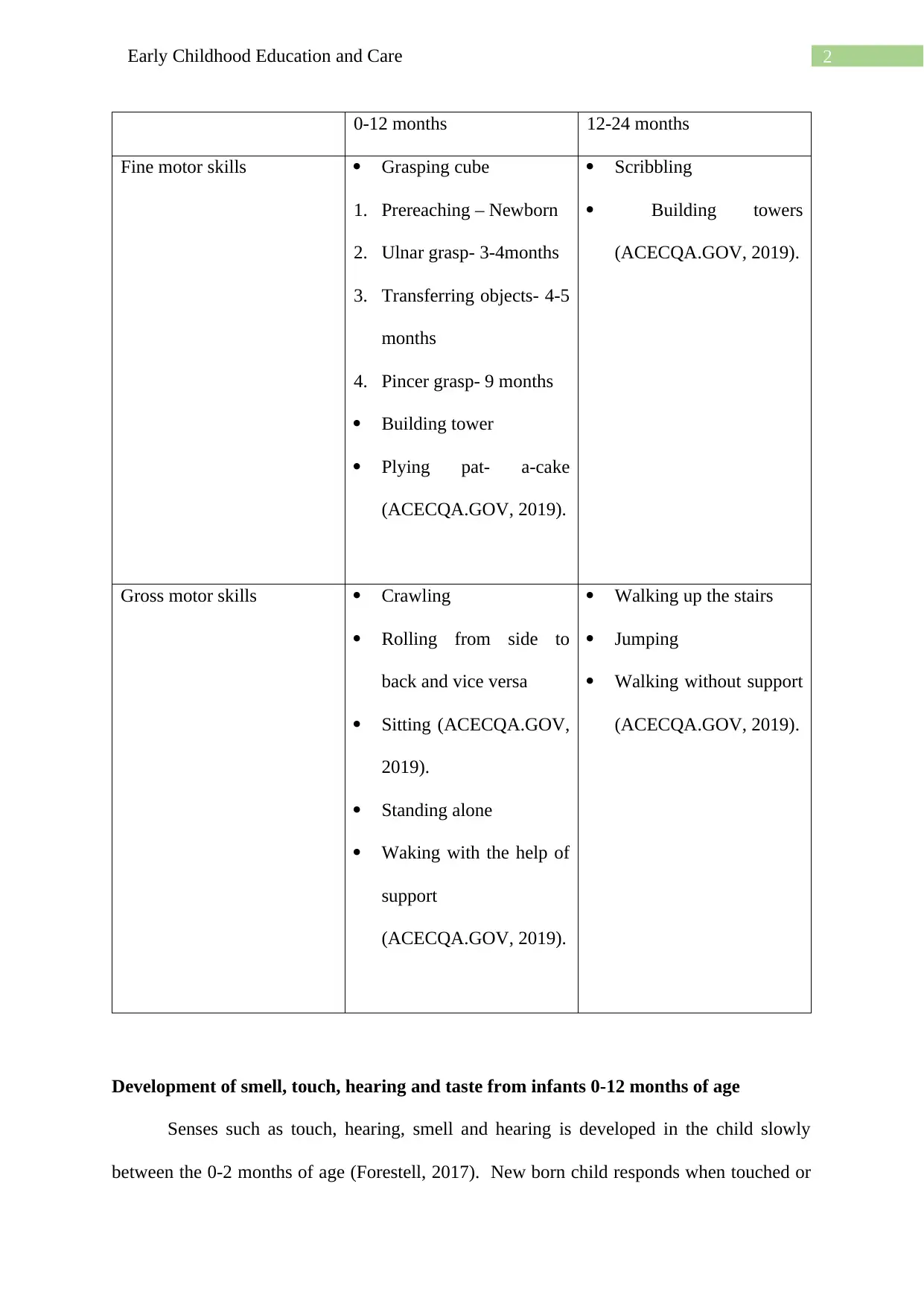
2Early Childhood Education and Care
0-12 months 12-24 months
Fine motor skills Grasping cube
1. Prereaching – Newborn
2. Ulnar grasp- 3-4months
3. Transferring objects- 4-5
months
4. Pincer grasp- 9 months
Building tower
Plying pat- a-cake
(ACECQA.GOV, 2019).
Scribbling
Building towers
(ACECQA.GOV, 2019).
Gross motor skills Crawling
Rolling from side to
back and vice versa
Sitting (ACECQA.GOV,
2019).
Standing alone
Waking with the help of
support
(ACECQA.GOV, 2019).
Walking up the stairs
Jumping
Walking without support
(ACECQA.GOV, 2019).
Development of smell, touch, hearing and taste from infants 0-12 months of age
Senses such as touch, hearing, smell and hearing is developed in the child slowly
between the 0-2 months of age (Forestell, 2017). New born child responds when touched or
0-12 months 12-24 months
Fine motor skills Grasping cube
1. Prereaching – Newborn
2. Ulnar grasp- 3-4months
3. Transferring objects- 4-5
months
4. Pincer grasp- 9 months
Building tower
Plying pat- a-cake
(ACECQA.GOV, 2019).
Scribbling
Building towers
(ACECQA.GOV, 2019).
Gross motor skills Crawling
Rolling from side to
back and vice versa
Sitting (ACECQA.GOV,
2019).
Standing alone
Waking with the help of
support
(ACECQA.GOV, 2019).
Walking up the stairs
Jumping
Walking without support
(ACECQA.GOV, 2019).
Development of smell, touch, hearing and taste from infants 0-12 months of age
Senses such as touch, hearing, smell and hearing is developed in the child slowly
between the 0-2 months of age (Forestell, 2017). New born child responds when touched or
⊘ This is a preview!⊘
Do you want full access?
Subscribe today to unlock all pages.

Trusted by 1+ million students worldwide
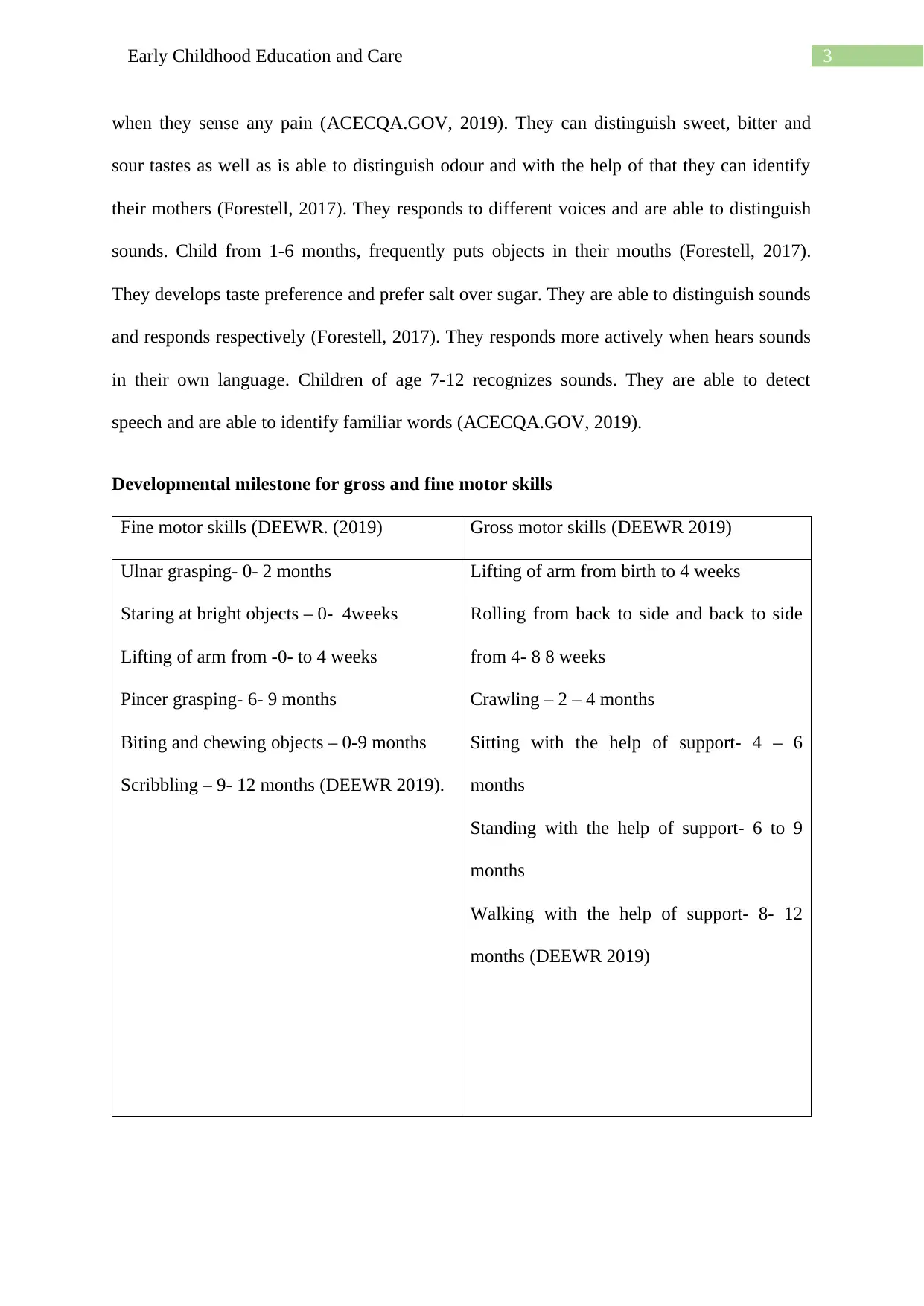
3Early Childhood Education and Care
when they sense any pain (ACECQA.GOV, 2019). They can distinguish sweet, bitter and
sour tastes as well as is able to distinguish odour and with the help of that they can identify
their mothers (Forestell, 2017). They responds to different voices and are able to distinguish
sounds. Child from 1-6 months, frequently puts objects in their mouths (Forestell, 2017).
They develops taste preference and prefer salt over sugar. They are able to distinguish sounds
and responds respectively (Forestell, 2017). They responds more actively when hears sounds
in their own language. Children of age 7-12 recognizes sounds. They are able to detect
speech and are able to identify familiar words (ACECQA.GOV, 2019).
Developmental milestone for gross and fine motor skills
Fine motor skills (DEEWR. (2019) Gross motor skills (DEEWR 2019)
Ulnar grasping- 0- 2 months
Staring at bright objects – 0- 4weeks
Lifting of arm from -0- to 4 weeks
Pincer grasping- 6- 9 months
Biting and chewing objects – 0-9 months
Scribbling – 9- 12 months (DEEWR 2019).
Lifting of arm from birth to 4 weeks
Rolling from back to side and back to side
from 4- 8 8 weeks
Crawling – 2 – 4 months
Sitting with the help of support- 4 – 6
months
Standing with the help of support- 6 to 9
months
Walking with the help of support- 8- 12
months (DEEWR 2019)
when they sense any pain (ACECQA.GOV, 2019). They can distinguish sweet, bitter and
sour tastes as well as is able to distinguish odour and with the help of that they can identify
their mothers (Forestell, 2017). They responds to different voices and are able to distinguish
sounds. Child from 1-6 months, frequently puts objects in their mouths (Forestell, 2017).
They develops taste preference and prefer salt over sugar. They are able to distinguish sounds
and responds respectively (Forestell, 2017). They responds more actively when hears sounds
in their own language. Children of age 7-12 recognizes sounds. They are able to detect
speech and are able to identify familiar words (ACECQA.GOV, 2019).
Developmental milestone for gross and fine motor skills
Fine motor skills (DEEWR. (2019) Gross motor skills (DEEWR 2019)
Ulnar grasping- 0- 2 months
Staring at bright objects – 0- 4weeks
Lifting of arm from -0- to 4 weeks
Pincer grasping- 6- 9 months
Biting and chewing objects – 0-9 months
Scribbling – 9- 12 months (DEEWR 2019).
Lifting of arm from birth to 4 weeks
Rolling from back to side and back to side
from 4- 8 8 weeks
Crawling – 2 – 4 months
Sitting with the help of support- 4 – 6
months
Standing with the help of support- 6 to 9
months
Walking with the help of support- 8- 12
months (DEEWR 2019)
Paraphrase This Document
Need a fresh take? Get an instant paraphrase of this document with our AI Paraphraser
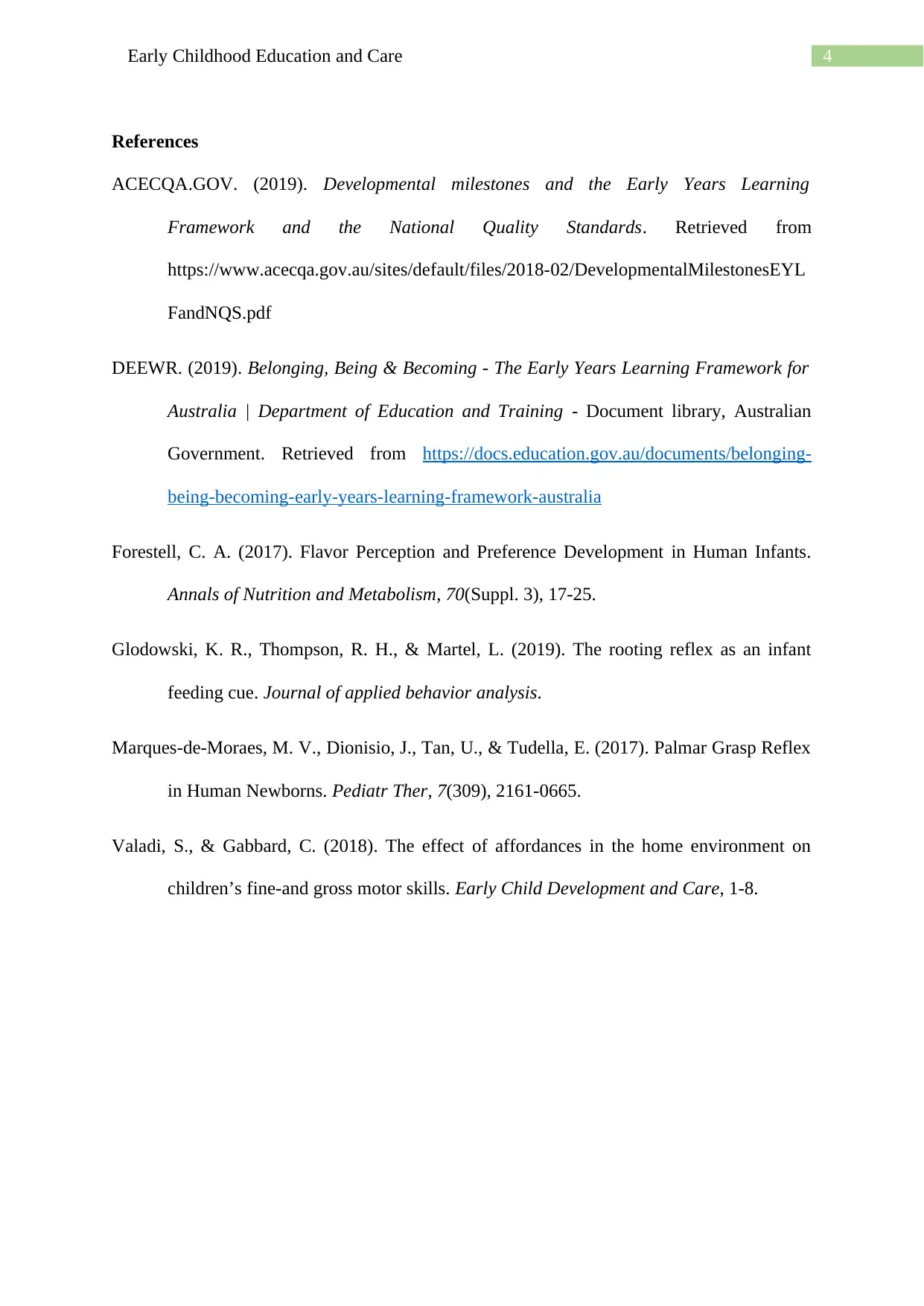
4Early Childhood Education and Care
References
ACECQA.GOV. (2019). Developmental milestones and the Early Years Learning
Framework and the National Quality Standards. Retrieved from
https://www.acecqa.gov.au/sites/default/files/2018-02/DevelopmentalMilestonesEYL
FandNQS.pdf
DEEWR. (2019). Belonging, Being & Becoming - The Early Years Learning Framework for
Australia | Department of Education and Training - Document library, Australian
Government. Retrieved from https://docs.education.gov.au/documents/belonging-
being-becoming-early-years-learning-framework-australia
Forestell, C. A. (2017). Flavor Perception and Preference Development in Human Infants.
Annals of Nutrition and Metabolism, 70(Suppl. 3), 17-25.
Glodowski, K. R., Thompson, R. H., & Martel, L. (2019). The rooting reflex as an infant
feeding cue. Journal of applied behavior analysis.
Marques-de-Moraes, M. V., Dionisio, J., Tan, U., & Tudella, E. (2017). Palmar Grasp Reflex
in Human Newborns. Pediatr Ther, 7(309), 2161-0665.
Valadi, S., & Gabbard, C. (2018). The effect of affordances in the home environment on
children’s fine-and gross motor skills. Early Child Development and Care, 1-8.
References
ACECQA.GOV. (2019). Developmental milestones and the Early Years Learning
Framework and the National Quality Standards. Retrieved from
https://www.acecqa.gov.au/sites/default/files/2018-02/DevelopmentalMilestonesEYL
FandNQS.pdf
DEEWR. (2019). Belonging, Being & Becoming - The Early Years Learning Framework for
Australia | Department of Education and Training - Document library, Australian
Government. Retrieved from https://docs.education.gov.au/documents/belonging-
being-becoming-early-years-learning-framework-australia
Forestell, C. A. (2017). Flavor Perception and Preference Development in Human Infants.
Annals of Nutrition and Metabolism, 70(Suppl. 3), 17-25.
Glodowski, K. R., Thompson, R. H., & Martel, L. (2019). The rooting reflex as an infant
feeding cue. Journal of applied behavior analysis.
Marques-de-Moraes, M. V., Dionisio, J., Tan, U., & Tudella, E. (2017). Palmar Grasp Reflex
in Human Newborns. Pediatr Ther, 7(309), 2161-0665.
Valadi, S., & Gabbard, C. (2018). The effect of affordances in the home environment on
children’s fine-and gross motor skills. Early Child Development and Care, 1-8.
1 out of 5
Related Documents
Your All-in-One AI-Powered Toolkit for Academic Success.
+13062052269
info@desklib.com
Available 24*7 on WhatsApp / Email
![[object Object]](/_next/static/media/star-bottom.7253800d.svg)
Unlock your academic potential
Copyright © 2020–2025 A2Z Services. All Rights Reserved. Developed and managed by ZUCOL.





